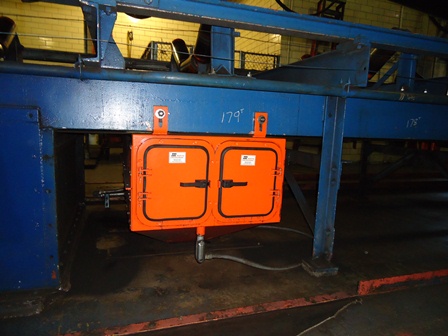Martin® Washbox™ Installated At Midwestern Utility Plant
Publicado: September 21st 2012
 Customized design squelches dust and reduces carryback.
Customized design squelches dust and reduces carryback.
In a move designed to reduce maintenance and better control fugitive material, an innovative Michigan power supplier has installed customized wash boxes from Martin Engineering on its coal conveyor belts, slashing cleanup time while drastically reducing surface dust and airborne particles. Believed to be the first wash boxes used successfully on the tripper floor of a PRB coal operation in the U.S., the units have now been installed in six locations within the company’s network of Midwestern plants.
“PRB coal is very volatile,” explained Martin Engineering Territory Manager Chris Griffin. “It tends to burn at higher BTUs than some other types of coal, but it’s notoriously brittle. So transportation and handling cause it to break up into small pieces, generating fine particles. It also absorbs moisture more readily, so in humid or rainy weather, it can be very difficult to remove from the belts.”
Coal at the facility is fed either by rail, with a dumper that inverts the car and empties it directly onto a feeder conveyor, or with front loaders working off stockpiles in the yard. Both methods have the potential to generate dust, which would accumulate on flat surfaces and was sometimes visible in the air.
The utility wanted to continue its history of good environmental stewardship by reducing airborne dust, but management also recognized the potential to reduce the maintenance hours needed to remove surface build-up. Not surprisingly, the dust was worst on the facility’s largest conveyors, with up to 1/8" accumulating each day. That build-up required daily removal, with workers sweeping, shoveling, vacuuming and/or washing down the affected areas.
“We used belt scrapers, brush cleaners and dust seals at various points on the conveyors, but the components were aging, and had originally been installed when the plant burned a different type of coal,” commented a senior plant engineer. “We knew there were technologies available to improve our material control.”
As part of a larger program to overhaul critical parts of the conveyor system, plant officials researched wash systems, belt cleaners, transfer points, chutes, high-efficiency dust seals and insertable air cleaners. Martin Engineering also took benchmark dust readings, finding that when the 42-inch wide belt was moving 817 tons per hour at 475 feet per minute, it resulted in an estimated dry weight carryback of more than 20 tons per year with the existing components in place.
As a first step in dealing with the dust issues, Martin Engineering installed a pre-cleaner on the belt, then ran the carryback test a second time. Results showed an improvement of more than 50%, but still estimated a dry weight carryback of around 8 tons.
Members of the utility staff discussed the Martin® Washbox™ Cleaning System option with Martin Engineering, identifying it as a possible solution. Because of the physical properties of PRB coal, the two companies collaborated on design modifications to suit the specific fuel and operating conditions. Changes included such features as special filtration to allow the utility to use a non-potable water supply instead of city water and adding a hose line to each wash box to facilitate cleanout.
“When it comes to bulk material handling, one size definitely does not fit all,” Griffin said. “Our approach is to engineer custom solutions that meet the needs of individual customers and applications. Often that requires us to go beyond products off the shelf.”
Once the wash box was installed and modified, the results were quickly apparent. A third carryback test revealed that together the pre-cleaner and wash box delivered a 99% reduction in estimated dry weight carryback. On a daily basis, that wouldn’t be enough coal dust to fill a hard hat.
“Visible dust in the air has been virtually eliminated,” the engineer continued. “And dust cleanup has been dramatically reduced. It’s paid for itself many times over.” The utility’s insurers also approved of the upgrades. “Our provider called it the cleanest facility of its type that he’d ever seen.”
Asked to summarize the experience overall, the engineer added, “Martin Engineering has established a design standard that’s effective, robust and user-friendly, one that accommodates our tripper configuration. It’s good technology, prudently applied and modified to suit our specific operating conditions. With that approach, covering the basics and doing it well, chances are you’ll get excellent results.”